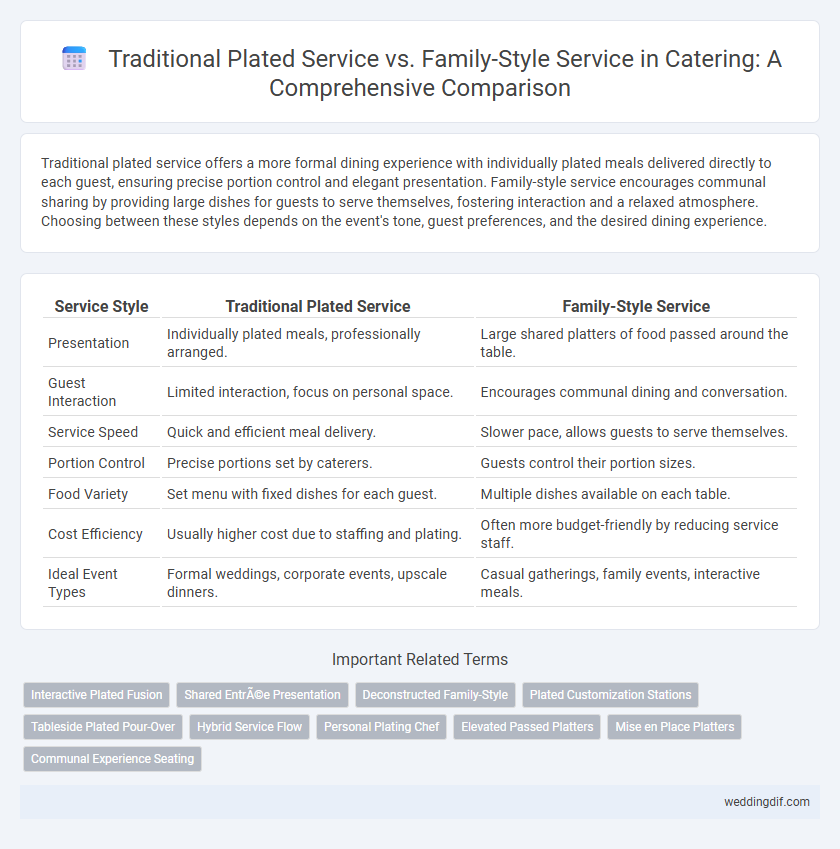Traditional plated service offers a more formal dining experience with individually plated meals delivered directly to each guest, ensuring precise portion control and elegant presentation. Family-style service encourages communal sharing by providing large dishes for guests to serve themselves, fostering interaction and a relaxed atmosphere. Choosing between these styles depends on the event's tone, guest preferences, and the desired dining experience.
Table of Comparison
| Service Style | Traditional Plated Service | Family-Style Service |
|---|---|---|
| Presentation | Individually plated meals, professionally arranged. | Large shared platters of food passed around the table. |
| Guest Interaction | Limited interaction, focus on personal space. | Encourages communal dining and conversation. |
| Service Speed | Quick and efficient meal delivery. | Slower pace, allows guests to serve themselves. |
| Portion Control | Precise portions set by caterers. | Guests control their portion sizes. |
| Food Variety | Set menu with fixed dishes for each guest. | Multiple dishes available on each table. |
| Cost Efficiency | Usually higher cost due to staffing and plating. | Often more budget-friendly by reducing service staff. |
| Ideal Event Types | Formal weddings, corporate events, upscale dinners. | Casual gatherings, family events, interactive meals. |
Understanding Traditional Plated Service in Wedding Catering
Traditional plated service in wedding catering involves individually prepared meals served directly to guests at their seats, ensuring precise portion control and elegant presentation. This method allows caterers to accommodate specific dietary restrictions and preferences with ease, enhancing the dining experience. The structured nature of plated service often results in a smoother, more formal reception flow, making it ideal for upscale weddings.
What Defines Family-Style Service at Weddings?
Family-style service at weddings is defined by communal dining where guests share dishes passed around the table, fostering interaction and a warm, intimate atmosphere. Unlike traditional plated service, which offers individually portioned meals, family-style encourages a relaxed, home-like experience with multiple dish options for guests to choose from. This style enhances guest engagement and promotes a sense of togetherness during the event.
Key Differences Between Plated and Family-Style Catering
Traditional plated service offers individually portioned meals served directly to guests, ensuring precise presentation and controlled portion sizes. Family-style catering features shared dishes placed on the table, promoting a communal dining experience and allowing guests to customize their servings. While plated service emphasizes efficiency and formality, family-style encourages interaction and a more relaxed atmosphere.
Guest Experience: Plated Service vs Family-Style
Traditional plated service offers guests a refined dining experience with individually portioned dishes, ensuring consistency and personalized presentation. Family-style service encourages communal interaction by allowing guests to serve themselves from shared platters, fostering a warm and convivial atmosphere. Both methods impact guest experience differently, with plated service emphasizing formality and precision, while family-style promotes social engagement and a relaxed vibe.
Presentation and Aesthetics: Comparing Both Styles
Traditional plated service offers a refined and elegant presentation with individually prepared dishes artistically arranged on each plate, creating a visually appealing and uniform dining experience. Family-style service emphasizes communal dining with large platters or bowls passed around the table, fostering a warm, inviting atmosphere but resulting in a less polished presentation. Both styles offer distinct aesthetic experiences, with plated service showcasing meticulous detail and family-style promoting a casual, shared ambiance.
Logistics and Staffing Requirements
Traditional plated service demands precise coordination and a higher staff-to-guest ratio to efficiently serve individually plated meals, ensuring timely delivery and presentation quality. Family-style service reduces the number of servers needed by allowing guests to serve themselves from shared dishes, requiring careful table setting and monitoring to maintain flow and replenish food. Both methods necessitate meticulous planning, but plated service typically involves more complex logistics and increased labor costs compared to the communal, less staff-intensive family-style approach.
Menu Flexibility and Dietary Accommodations
Traditional Plated Service offers limited menu flexibility, as guests choose from predetermined options, which may restrict dietary accommodations for allergies or preferences. Family-Style Service enables a more adaptable approach, allowing multiple dishes to be shared and guests to select portions according to their dietary needs. This method enhances customization and inclusivity, making it ideal for diverse dietary requirements such as gluten-free, vegetarian, or vegan options.
Budget Considerations: Plated vs Family-Style
Traditional plated service typically incurs higher costs due to the need for additional staff to serve each guest individually and the use of specialized dinnerware and presentation materials. Family-style service can reduce labor expenses since guests serve themselves from shared dishes, but it may require larger quantities of food to accommodate varying appetites, potentially increasing overall food costs. Budget-conscious catering decisions should weigh the trade-offs between staffing fees and food consumption when choosing between plated and family-style options.
Which Service Style Suits Your Wedding Theme?
Traditional plated service suits formal wedding themes, offering a structured and elegant dining experience with individual portions served to each guest. Family-style service complements rustic or casual weddings, encouraging communal dining and interaction through shared platters placed at the table. Choosing between these styles depends on the desired atmosphere, guest interaction level, and overall wedding ambiance.
Final Tips for Choosing the Right Catering Style
Choosing between Traditional Plated Service and Family-Style Service depends on the event's formality, guest interaction, and logistical needs. Plated service offers precise portion control and a streamlined dining experience, ideal for formal occasions with large guest lists. Family-style encourages social engagement and sharing, best suited for intimate gatherings where a relaxed atmosphere is desired.
Traditional Plated Service vs Family-Style Service for catering. Infographic

 weddingdif.com
weddingdif.com